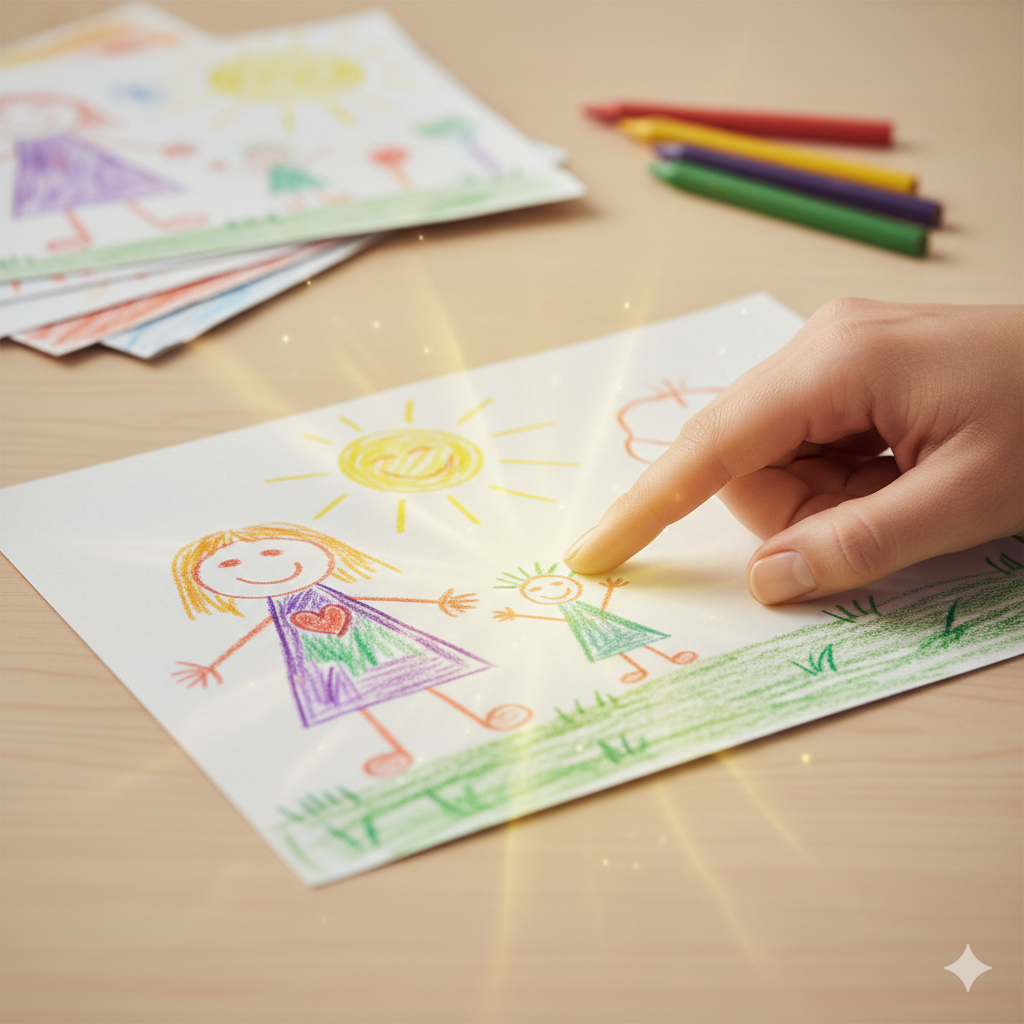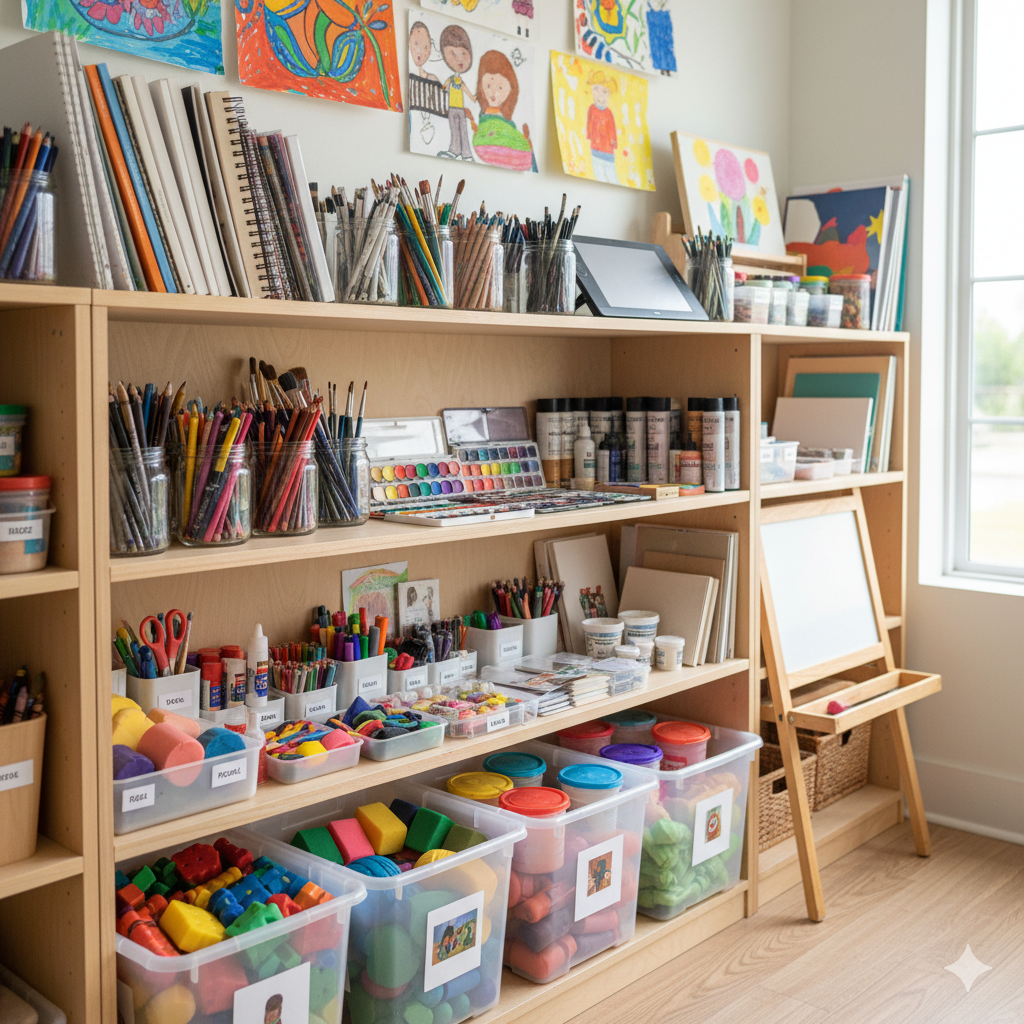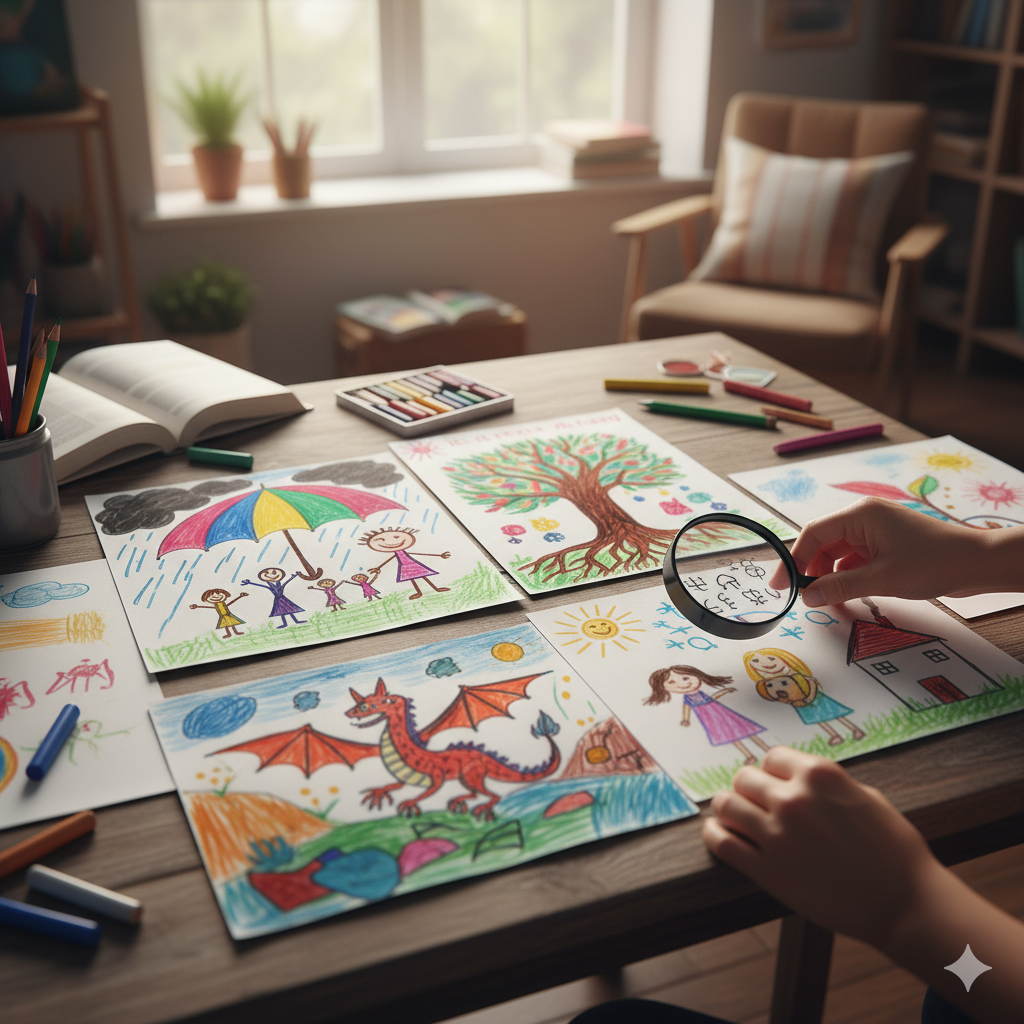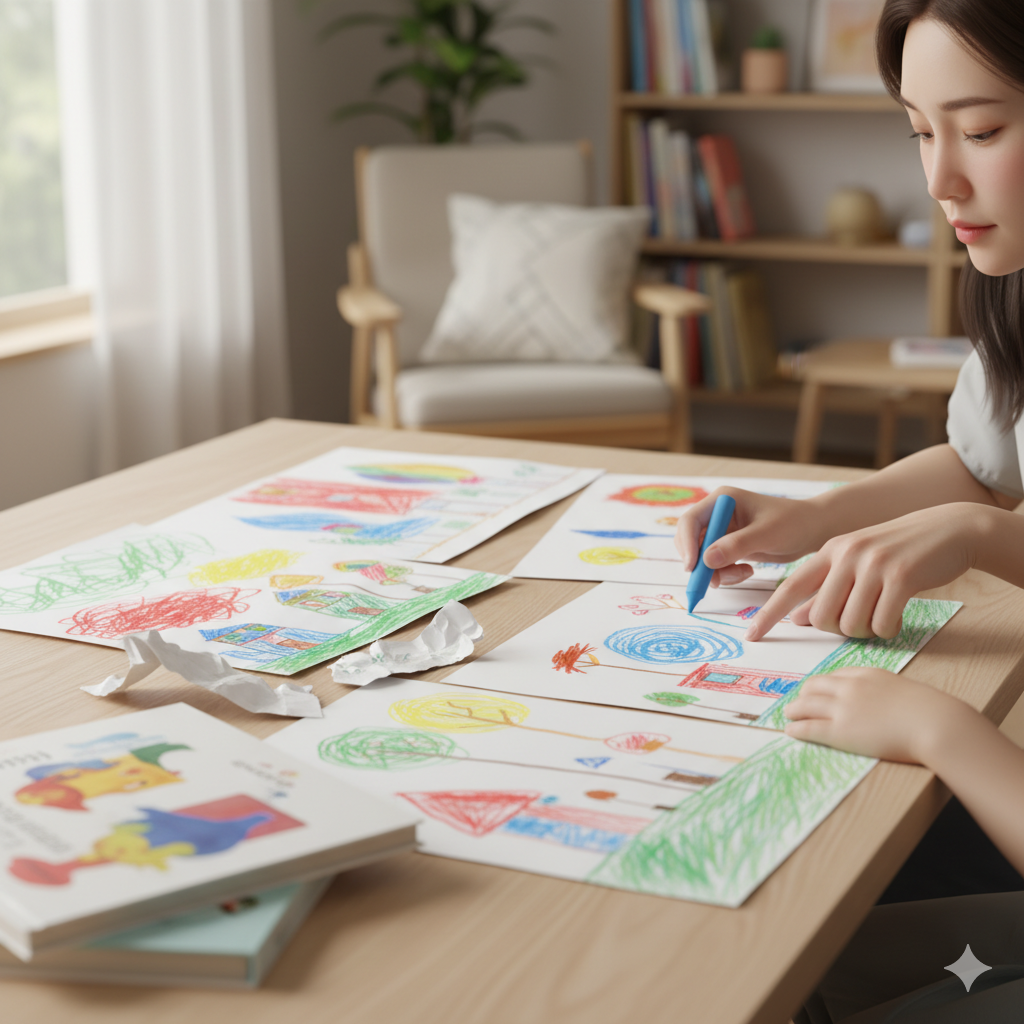How to Analyze Your Child's Drawing: A Step-by-Step Guide
I remember the first time my daughter handed me one of her drawings. It was a swirling mass of purple and green lines that looked like abstract art to my adult eyes, but to her, it was clearly "Mommy dancing with the cat." That moment taught me something profound: children's artwork is a language all its own, and when we learn to listen, we can hear incredible stories about their inner world.
As parents, we often look at our children's artwork with wonder and pride, but many of us secretly wish we could understand what their drawings are really telling us about their development, emotions, and inner world. The good news is that while professional art therapy requires specialized training, parents can absolutely learn to observe and interpret their children's drawings in ways that provide valuable insights into their growth and well-being.
This guide will help you develop the skills to analyze your child's artwork thoughtfully and responsibly. Think of it as learning a new language—one that speaks through colors, shapes, and composition rather than words.
Understanding What Your Child's Art Can Tell You
Before we dive into the how-to, let's talk about what we're actually looking for when we analyze children's drawings. Your child's artwork can reveal fascinating insights about their developmental stage, emotional state, social relationships, and how they see themselves in the world. It's like getting a peek into their inner landscape.
But here's the crucial part: children's drawings are windows into their world, not crystal balls. They can't predict the future, diagnose psychological conditions, or tell us absolute truths about what's happening in their lives. Art is symbolic and open to interpretation—what looks like anger to one parent might simply be a child experimenting with bold colors to another.
The most important thing to remember is that every child is unique. What's normal for one child might be completely different for another, and that's perfectly okay. We're not looking for problems; we're looking for understanding.
Before You Start: Setting the Right Mindset
Before you begin analyzing your child's artwork, there are a few ethical considerations to keep in mind. First and foremost, respect your child's privacy. Don't share their drawings publicly without permission, and be mindful of how you discuss their art in front of others.
Avoid the temptation to over-interpret single drawings. One dark picture doesn't necessarily mean your child is depressed, just as one bright, cheerful drawing doesn't guarantee everything is perfect in their world. Look for patterns over time rather than reading too much into individual pieces.
Most importantly, focus on the positive aspects of their artistic expression. Celebrate their creativity, growth, and unique perspective. If you notice concerning patterns that persist over time, that's when you might want to seek professional guidance. Remember, art is just one piece of the puzzle when it comes to understanding your child.
Step 1: Take in the Big Picture
When my son was four, he drew what he called "the biggest house ever" that took up almost the entire page. His tiny stick figures looked like ants next to this massive structure. I learned later that this wasn't just artistic expression—it was a window into how he was processing our recent move to a much larger home.
Start by stepping back and looking at your child's drawing as a whole. How much of the page did they use? Where did they place their main subjects? These simple observations can reveal a lot about their current emotional state and personality.
The Story of Size
Children who fill the page with large drawings are often expressing confidence, high energy, or strong emotions. They might feel important or want attention, and this could reflect an outgoing, expressive personality. On the flip side, children who create small, delicate drawings might be feeling more cautious or introspective. This isn't necessarily a problem—it could simply mean they're detail-oriented or feeling more reserved that day.
Where Everything Goes
Pay attention to where your child places their main subjects on the page. When my daughter draws herself in the center of the page, it often coincides with times when she's feeling particularly confident or wants to be the star of her own story. Drawings placed at the top of the page might suggest aspirations or dreams, while those at the bottom could indicate a need for grounding or security.
Children who consistently draw on the left side of the page might be more introspective or focused on the past, while those who favor the right side could be looking toward the future or feeling more extroverted. Again, these are just patterns to notice, not hard-and-fast rules.
The Art of Space
Some children are natural space-fillers, creating busy, energetic compositions that leave little room for empty space. These kids often have lots of ideas to express and feel confident in their abilities. Others prefer sparse, minimalist drawings, which might reflect carefulness, perfectionism, or simply a different aesthetic preference.
Notice how your child handles margins and borders. Children who draw right to the edges might be confident or impulsive, while those who leave wide margins could be more careful or cautious. Some children naturally create borders or frames around their drawings, which might indicate a need for structure or control in their lives.
Step 2: Listen to the Colors
I'll never forget the week my normally colorful daughter suddenly started drawing everything in black and gray. When I gently asked about it, she explained that she was "practicing being a shadow" because she felt invisible at school. That moment taught me how much children communicate through color choices.
Colors in children's art are like emotional weather reports—they give us clues about what's happening in their inner world. But here's the thing: color interpretation isn't an exact science. A child who loves red might simply find it visually appealing, while another might be using it to express strong emotions.
The Emotional Palette
Let's start with red, which often shows up when children are feeling energetic, passionate, or intense. It might indicate excitement, confidence, or even anger, but it can also simply reflect love, warmth, or connection. My son went through a phase where everything he drew was red because he was obsessed with fire trucks—not because he was angry, but because he was fascinated by their power and importance.
Blue, on the other hand, often appears when children are feeling calm, peaceful, or contemplative. It might suggest sadness or withdrawal, but it can also indicate trust, reliability, or a deep connection to something meaningful. I've seen children use blue to represent water, sky, or simply a peaceful mood.
Yellow typically signals happiness, optimism, or creativity. It might indicate joy, energy, or intellectual curiosity. Green often represents nature, growth, or balance, though it can sometimes suggest jealousy or immaturity depending on the context.
Purple is fascinating because it often appears in the artwork of highly imaginative or sensitive children. It might indicate creativity, mystery, or high emotional sensitivity. Black can be tricky—while it might suggest grief, depression, or trauma, it can also simply indicate a child's preference for bold contrast or their attempt to create something sophisticated.
The Intensity Tells a Story
Pay attention not just to which colors your child chooses, but how intensely they use them. Bright, saturated colors often reflect high energy, enthusiasm, or strong emotions. They might suggest confidence or a positive mood, but they could also indicate that your child simply loves vibrant, eye-catching art.
Muted or pale colors might suggest calmness, subtlety, or restraint. They could indicate insecurity or withdrawal, but they might also reflect a contemplative mood or simply your child's artistic preference for softer tones.
When children create monochromatic drawings (using only one color), it could indicate focus, concentration, or emotional intensity. Sometimes it's just a matter of available materials or artistic experimentation. However, if your child consistently avoids color when they previously used it enthusiastically, it might be worth gently exploring what's happening in their world.
Step 3: Feel the Energy in the Lines
The way your child draws lines can tell you almost as much as the colors they choose. I remember watching my daughter switch from her usual delicate, careful lines to bold, heavy strokes during a particularly challenging week at school. When I asked her about it later, she said she was "drawing with all her feelings."
The Language of Lines
Heavy, bold lines often indicate confidence, determination, or strong emotions. They might suggest assertiveness or high energy, but they can also simply reflect a child's developing motor strength or their excitement about what they're creating. I've seen children use bold lines when they're proud of their work or when they want to make sure their drawing "shows up" on the page.
Light, delicate lines might suggest carefulness, sensitivity, or a gentle personality. They could indicate anxiety or withdrawal, but they might also reflect a child who's naturally thoughtful and methodical. Some children simply prefer the aesthetic of delicate, refined artwork.
Erratic or broken lines can be particularly telling. They might indicate anxiety, nervousness, or uncertainty, but they could also suggest motor control difficulties or perfectionism. I've noticed that children who are learning new techniques often create more erratic lines as they experiment and practice.
Smooth, flowing lines typically suggest calmness, confidence, or emotional stability. They might reflect artistic skill or practice, but they can also indicate a peaceful, harmonious personality. These are often the lines of children who are comfortable with their creative process.
The Weight of the Mark
The pressure your child uses when drawing can reveal their emotional state. Heavy pressure often indicates strong emotions, intensity, or determination. It might suggest excitement, high energy, or even stress, but it can also simply reflect a child's natural motor strength or their enthusiasm for the activity.
Light pressure might suggest gentleness, sensitivity, or insecurity, but it could also indicate a child who's being careful or who naturally has a lighter touch. Some children prefer the look of light, airy drawings.
Variable pressure can be especially interesting to observe. It might indicate emotional fluctuation or mood changes, but it could also suggest artistic experimentation or the natural development of motor control. Children who are learning to modulate their pressure are often developing important fine motor skills.
Step 4: Assess Developmental Milestones
Age-Appropriate Expectations
2-3 Years: Scribble Stage
During the scribble stage, children create random marks and scribbles using whole-arm movements with no representational intent, focusing on exploration of cause and effect.
3-4 Years: Controlled Scribbling
Controlled scribbling shows more controlled movements with beginning attempts to name scribbles, first attempts at shapes, and emerging symbolic thinking.
4-5 Years: Symbolic Representation
Symbolic representation includes first human figures (often "tadpole" people), basic shapes representing objects, beginning use of color meaningfully, and stories emerging from artwork.
5-7 Years: Detailed Realism
Detailed realism features more detailed human figures, recognizable objects and scenes, use of baseline (ground line), and beginning to show depth and perspective.
7-9 Years: Narrative Art
Narrative art demonstrates complex scenes with multiple elements, clear narratives in drawings, beginning to show emotions in figures, and more realistic proportions.
Red Flags for Developmental Concerns
Significant Delays:
Be aware of significant delays when a child is significantly behind age-appropriate milestones, shows regression in previously acquired skills, exhibits extreme avoidance of drawing activities, or creates persistent concerning themes.
When to Seek Professional Help:
Seek professional help when a child shows signs of developmental delays, artwork suggests serious emotional distress, a child expresses concerning thoughts or feelings, or you have persistent worries about your child's development.
Step 5: Look for Emotional Content
Facial Expressions and Body Language
Happy Expressions:
Happy expressions are characterized by smiling faces with upturned mouths, bright and open eyes, relaxed body postures, and upward-pointing elements.
Sad or Angry Expressions:
Sad or angry expressions may show frowns with downturned mouths, tears or closed or angry eyes, tense or aggressive body postures, and downward-pointing elements.
Neutral Expressions:
Neutral expressions typically feature straight-line mouths, simple dot eyes, basic body shapes, and minimal emotional expression.
Symbolic Elements
Positive Symbols:
Positive symbols include suns, rainbows, and flowers, hearts, stars, and butterflies, bright colors with upward movement, and open, welcoming spaces.
Negative Symbols:
Negative symbols might include storms, dark clouds, and monsters, weapons, barriers, and walls, dark colors with downward movement, and closed, constricted spaces.
Neutral Symbols:
Neutral symbols typically involve houses, trees, and basic shapes, everyday objects, balanced compositions, and moderate color use.
Step 6: Consider Social and Family Relationships
Family Drawings
Who's Included:
When analyzing family drawings, note which family members are present, observe the order in which people are drawn, consider who might be missing and why, and look for symbolic representations of family.
Size and Placement:
Pay attention to size and placement where larger figures may represent importance, closer placement may indicate emotional closeness, separated figures might suggest distance or conflict, and self-placement shows how the child sees their role.
Interaction and Connection:
Examine interaction and connection by asking if family members are holding hands or connected, whether they're facing each other or away, if they appear happy, neutral, or sad, and whether there are barriers or separations between figures.
Peer Relationships
Group Scenes:
In group scenes, observe how the child positions themselves in groups, whether they're included or excluded, if they appear confident or shy, and how they interact with others.
Individual Figures:
When examining individual figures, consider whether friends are portrayed positively or negatively, if they appear similar to or different from the child, whether there are signs of conflict or harmony, and what activities they're shown doing together.
Step 7: Document and Track Patterns
Keeping an Art Portfolio
What to Document:
Document the date and age of the child, context of the drawing including mood and recent events, the child's explanation of the artwork, your observations and interpretations, and any significant life events or changes.
How to Organize:
Organize your documentation using a binder or digital portfolio, including photos of the artwork, writing notes about the child's comments, tracking changes over time, and noting any concerning patterns.
Looking for Patterns
Positive Patterns:
Look for positive patterns including increasing detail and complexity, growing confidence in line work, expanding color palette, more sophisticated storytelling, and improved motor control.
Concerning Patterns:
Be aware of concerning patterns such as persistent dark or disturbing themes, regression in previously acquired skills, extreme avoidance of certain subjects, repetitive concerning imagery, and significant changes in style or content.
Step 8: Ask the Right Questions
Open-Ended Questions
About the Process:
Ask about the process with questions like "Tell me about making this drawing," "What was your favorite part?," "How did you decide what colors to use?," and "What was challenging about this?"
About the Content:
Explore the content by asking "Tell me about this picture," "What's happening here?," "How do the people in your drawing feel?," and "What would happen next in this story?"
About the Experience:
Understand the experience through questions like "How did you feel while you were drawing?," "What were you thinking about?," "What does this drawing mean to you?," and "Is there anything you'd like to change?"
Questions to Avoid
Leading Questions:
Avoid leading questions like "Is this person sad?," "Are you angry about something?," "Did something bad happen?," or "Are you worried about school?"
Judgmental Questions:
Stay away from judgmental questions such as "Why did you draw it that way?," "Couldn't you make it look better?," "What's wrong with this person?," or "Why didn't you include your sister?"
Step 9: Integrate Multiple Sources of Information
Combining Observations
Artwork + Behavior:
Consider how the drawing relates to recent behavior, whether there are themes that match emotional states, if the artwork reflects changes in personality, and whether there are inconsistencies that need attention.
Artwork + Life Events:
Examine if there have been recent changes or stresses, whether the drawing reflects current life circumstances, if there are themes related to recent experiences, and how life events might influence artistic expression.
Artwork + Development:
Evaluate whether the drawing matches developmental expectations, if there are signs of growth or regression, how this compares to previous artwork, and whether there are areas where support might be helpful.
Step 10: Know When to Seek Professional Help
Signs That Professional Help May Be Needed
Persistent Concerning Patterns:
Be alert for persistent concerning patterns including artwork that consistently suggests serious emotional distress, themes that persist over several months, significant regression in artistic development, and artwork that suggests trauma or abuse.
Behavioral Indicators:
Watch for behavioral indicators such as changes in mood, behavior, or academic performance, social withdrawal or isolation, increased aggression or acting out, and signs of anxiety or depression.
When to Consult Professionals:
Know when to consult professionals including a pediatrician for developmental concerns, child psychologist for emotional or behavioral issues, art therapist for specialized art-based therapy, and school counselor for academic or social concerns.
How to Approach Professional Consultation
Prepare Information:
Prepare for consultations by bringing samples of your child's artwork, documenting concerning patterns or changes, noting any life events or stresses, and being prepared to discuss your observations.
Questions to Ask:
Come prepared with questions like "Are these patterns normal for my child's age?," "What might this artwork be telling us?," "Do you think my child needs additional support?," and "What can I do at home to help?"
Conclusion
Learning to analyze your child's drawings is a valuable skill that can help you better understand their development, emotions, and inner world. However, it's important to remember that art interpretation is complex and should be approached with humility and caution.
The most important thing is to use your observations to support your child's growth and well-being. Focus on the positive aspects of their artistic expression, celebrate their creativity, and use your insights to provide appropriate support and encouragement.
Remember that every child is unique, and what's normal for one child might be different for another. Trust your instincts as a parent, but don't hesitate to seek professional help if you have serious concerns.
The goal isn't to become an expert art therapist, but to develop a deeper understanding of your child and their creative expression. When approached thoughtfully and responsibly, drawing analysis can be a valuable tool for supporting your child's development and strengthening your relationship with them.
Want to get professional insights into your child's artwork? Our AI-powered analysis tool can provide detailed information about the artistic techniques, developmental milestones, and creative expression patterns in your child's drawings. Try our child drawing analysis tool to discover what your child's art might be telling you about their growth and development.
---
Remember: This guide is for educational purposes only and should not replace professional evaluation. If you have concerns about your child's development or emotional well-being, please consult with a qualified professional.



